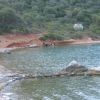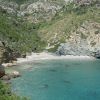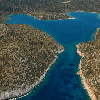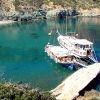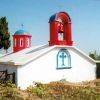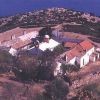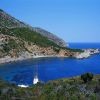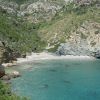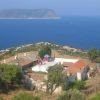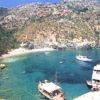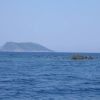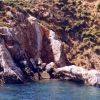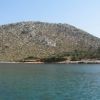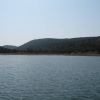PLANITIS & MONASTIRI bays in KYRA PANAGIA islet close to ALONISSOS
Planitis bay is one of the largest natural harbours in the Mediterranean, located on the northeastern coast of Kyra Panagia islet which is close to Alonissos. Its entrance is about 80 metres wide and then it divides into western and southern areas, each several hundred yards wide. It is the second natural harbour of Kyra Panagia island. The other one is Agios Petros and is located in the southern part of the island (see separate listing). Visiting Planitis and Monastiri bays worth only if the weather is very calm or when south winds prevail. However the visit is recommended only to those who love isolation and explorations of the wild virigin nature. Of course no facilities are available.
Arriving in Planitis by yacht or caïque one wonders why, with such an ideal natural harbour, no settlement has developed. The fact that the island belongs to Mount Athos appears to be the reason there has been no settlement in recent history. This is fortunate for the natural environment, which has remained undamaged except for over-grazing, and for the present-day visitor who can enjoy the genuinely natural countryside of an Aegean island.
With an area of 25 square kilometres Kyra Panayia is the largest of the desert islands. The hills are between 169 and 299 metres high. It was the ancient Alonnisos, and later named Pelagonisi. The island is now the property of the Grand Lavra monastery on Mount Athos, and takes its name from the monastery of the same name there. The story begins in 963 a.d., when Saint Athanasios bought the island from the Byzantine noblemen of Constantinople as a dependency of Mount Athos, which it supplied with food such meat, honey, oil, and wheat. It is well-known that women may not enter Mount Athos, but many will not be aware that neither are female animals allowed, so Athos's requirements of meat are met by its dependencies. This is how goat-farming started on Kyra Panayia, and the system whereby the island is rented from the Grand Lavra monastery by goat-farmers to graze their flocks continues to the present day.
The island's monastery, built in 1100 a.d., is situated on the South-eastern side. Up until 1984 there was still a monk there. The monastery overlooks the sea from its height, and resembles a small fortress, reminiscent of the times when pirates laid waste to the area. Its natural harbour is exposed to thesoutheastern winds that prevail in the summer in the Aegean and&
